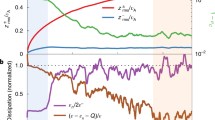Abstract
It is shown that small magnetic perturbations can significantly alter the rates of cyclotron growth, absorption, mode conversion, and refraction because of the sensitive dependence of these processes on the field strength in narrow layers. In particular, growth lengths are increased, absorption depths decreased, mode conversion becomes more effective, and turbulent refraction leads to isotropization of the emission. The criteria for significant effects to occur are derived and it is shown that they can be met by the few-percent field perturbations observed in coronal loops. Relative to the theory of cyclotron-maser emission in smoothly varying plasmas, perturbations enable fundamental o-mode (o1) and second-harmonic x-mode (x2) radiation to saturate more effectively, increase the chance of x1, o1, and x2 radiation escaping to infinity through absorption and mode-coupling windows, and partially isotropize radiation emitted near the x-mode cutoff. It is concluded that o1 and x1 emission are both likely to be present, and that x2 emission is possible under some circumstances. However, x1 radiation can escape only at near-parallel propagation (θ ≈ 0) or via mode conversion to the o-mode at θ ≈ 90°, whereas o1 and x2 emission can escape for a wide range of angles around θ = 0 and, under many circumstances, near θ = 90°.
Similar content being viewed by others
References
Aschwanden, M. J.: 1987, Solar Phys. 111, 113.
Aschwanden, M. J.: 1990a, Astron. Astrophys. Suppl. Ser. 85, 1141.
Aschwanden, M. J.: 1990b, Astron. Astrophys. 237, 512.
Benz, A. O.: 1986, Solar Phys. 104, 99.
Bornatici, M., Cano, R., De Barbieri, O., and Engelmann, F.: 1983, Nucl. Fusion 23, 1153.
Chiueh, T. and Zweibel, E. G.: 1987, Astrophys. J. 317, 900.
Crannell, C. J., Dulk, G. A., Kosugi, T., and Magun, A.: 1988, Solar Phys. 118, 155.
Dröge, F.: 1977, Astron. Astrophys. 57, 285.
Dulk, G. A.: 1985, Ann. Rev. Astron. Astrophys. 23, 169.
Elgarøy, Ø.: 1986, Solar Phys. 104, 43.
Fu, P., Jin, S., Zhao, R., Zheng, L., Liu, Y., Li, X., Wang, S., Chen, Z., and Hu, C.: 1986, in B. R. Dennis, L. E. Orwig, and A. L. Kiplinger (eds.), Rapid Fluctuations in Solar Flares, NASA Conf. Proc. 1449, p. 237.
Gaizauskas, V. and Tapping, K. F.: 1980, Astrophys. J. 241, 804.
Gary, D. E., Hurford, G. J., and Flees, D. J.: 1991, Astrophys. J. 369, 255.
Güdel, M.: 1990, Astron. Astrophys. 239, L1.
Güdel, M. and Zlobec, P.: 1991, Astron. Astrophys. 245, 299.
Hewitt, R. G. and Melrose, D. B.: 1983, Australian J. Phys. 36, 725.
Hewitt, R. G., Melrose, D. B., and Rönnmark, K. G.: 1982, Australian J. Phys. 35, 447.
Holman, G. D., Eichler, D., and Kundu, M. R.: 1980, in M. R. Kundu ad T. E. Gergely (eds.), ‘Radio Physics of the Sun’, IAU Symp. 86, 457.
McKean, M. E., Winglee, R. M., and Dulk, G. A.: 1989, Solar Phys. 122, 53.
Melrose, D. B.: 1980, Plasma Astrophysics, Vol. 2, Gordon and Breach, New York.
Melrose, D. B.: 1986, Instabilities in Space and Laboratory Plasmas, Cambridge University, Cambridge.
Melrose, D. B.: 1991, Astrophys. J., in press.
Melrose, D. B. and Dulk, G. A.: 1982a, Astrophys. J. 259, L41.
Melrose, D. B. and Dulk, G. A.: 1982b, Astrophys. J. 259, 844.
Melrose, D. B. and Dulk, G. A.: 1984, Astrophys. J. 282, 308.
Melrose, D. B., Hewitt, R. G., and Dulk, G. A.: 1984, J. Geophys. Res. 89, 897.
Miller, J. A., Guessoum, N., and Ramaty, R.: 1990, Astrophys. J. 361, 701.
Roberts, B., Edwin, P. M., and Benz, A. O.: 1983, Nature 305, 688.
Roberts, B., Edwin, P. M., and Benz, A. O.: 1984, Astrophys. J. 279, 857.
Robinson, P. A.: 1986, J. Plasma Phys. 36, 63.
Robinson, P. A.: 1989, Astrophys. J. 341, L99.
Robinson, P. A.: 1991, Solar Phys. 134, 299.
Rosenberg, H.: 1970, Astron. Astrophys. 9, 159.
Slottje, C: 1978, Nature 275, 520.
Stähli, M. and Magun, A.: 1986, Solar Phys. 104, 117.
Tajima, T., Benz, A. O., Thaker, M., and Leboeuf, J. N.: 1990, Astrophys. J. 353, 666.
Tapping, K. F.: 1983, Solar Phys. 87, 177.
Vlahos, L., Sharma, R. R., and Papadopoulos, K.: 1983, Astrophys. J. 275, 374.
Winglee, R. M. and Dulk, G. A.: 1986, Astrophys. J. 310, 432.
Winglee, R. M., Dulk, G. A., and Pritchett, P. L.: 1988, Astrophys. J. 328, 809.
Author information
Authors and Affiliations
Rights and permissions
About this article
Cite this article
Robinson, P.A. Effects of turbulence on the electron cyclotron-maser mechanism for solar microwave spike bursts. Sol Phys 136, 343–360 (1991). https://doi.org/10.1007/BF00146541
Received:
Revised:
Issue Date:
DOI: https://doi.org/10.1007/BF00146541



